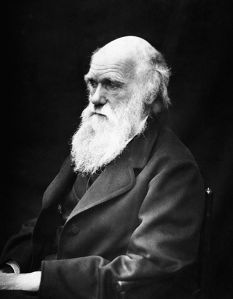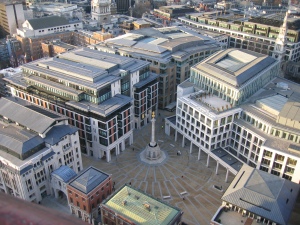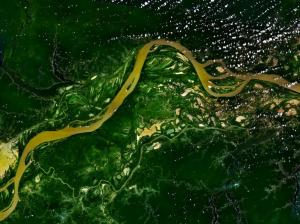Looking down on a rain forest
Tenth in a series beginning with Art in the family.
We must now try to draw a few of these strands together. Last time we applied the essentially Darwinian paradigm of selection and survival to works of art, and found it made a kind of sense.
In fact I think it makes sense in a fairly broad and transparent way. There is certainly variation going on, and replication; and competition, selection and survival. We now need to dig a bit deeper into what kind of selection we are dealing with.
This is where some of the strands connect. Natural selection is to do with the struggle for survival and replication in nature. Survival in science is to do with selection by empirical evidence: what survives (and is therefore treated as true) is what has so far survived every attempt to falsify. Economic selection is to do with demand: goods and services – and the people and entities who provide them – are selected for survival by being what the market selects against the competition.
Only the most naïve Romantic would see no overlap between the market in goods and services in general and the survival prospects of works of art. Artists are human and need to live. But overlap is all it is. Not all goods and services are to do with art, and not every selection of art involves an economic transaction.
With all these Darwinian or quasi-Darwinian processes we have an ‘aggregate state so far’. By this I mean what the overall process has led to and created. In nature, it is the sum-total of evolved species currently in existence, in all their ecologies, food chains, and parasitic, symbiotic and symbiotic relationships. It is both the jungle red in tooth and claw, and a dawn chorus in spring. Tomorrow, a hundred years from now, a thousand or a million years from now it will be something different.
In science it is the sum-total of today’s scientific knowledge, with every theory and hypothesis, every incomplete research project, every yawning gap. By tomorrow it will have changed. Ten years from now it will have changed even more, let alone a hundred years from now.
In economics it is the global market, with all its constituent local markets, current survivors, imminent bankruptcies, cartels, booms and recessions. Tomorrow will be another day – betting on the future is what makes the market.
In the world of art it is of course the world of art, construed as broadly as you please. It is every art market in the world, plus every market place of ideas which have any connection with art. It is the current stock price of every trend and movement; it is every hit parade and best-seller list, every review of every current record, film, novel and play. And much more of course. It is the aggregate total of everyone’s artistic choices, however free and informed or constrained and manipulated.
This is not of course an answer to the question we began with:
…how do you validate the arts? how do we validate a conclusion that Beethoven is great music? or Da Vinci a great painter, or Auden a great poet?
But it is a possible context for responding to it.
We must be careful not to look for something which is not there. If there was a God who made the universe and everything in it, we would be justified in wondering what the intention was, including the intention behind the natural world with all its animals, plants, bacteria and viruses. But if we are not justified in seeing a God behind it all, then we are not justified in seeing an intention behind the ‘aggregate state’ of what Darwinian processes in the natural world have so far led to. It is what it is, including intricate local architectures of interdependence like a coral reef or the Amazon rain forest. However vast and astonishing they are, they are only themselves and we have no reason to think they point to any truth or goal beyond.
In the case of art, again the current art world, with all its markets, trends, movements and canons is also what it is. But, unlike the natural world, in art we do have an ecosystem shot through with intention. Or rather intentions plural – all the varied and complex intentions of creators, producers, investors, consumers, critics, academics, educators and facilitators.
We have no reason to think the overall aggregate state of artistic endeavour and artistic appreciation points to any truth or goal beyond itself. We may not even have any objective criteria for deciding what is inside that aggregate state and what is outside: see Art in the family to Portrait of the artist as a chef d’oeuvre.
But the individual intentions of the participants are something very different. To see a created object or event as a work of art is, generally speaking, to see it as something intentionally created as a work of art, and to recognise that intention behind it. It may be that different categories of artwork only share family resemblances: see Art in the family. But this does not cast doubt on the intention to create something as a work of art. It also does not mean that artists cannot from time to time ‘push the envelope’ and create things which will only in time be appreciated as artworks. The environment changes all the time. As we said earlier:
Each artwork adds to the sum-total of social and cultural reality. It makes a difference and changes the world from what it was before, and therefore cannot but feed back into the generation of further artworks.
Artistic endeavour and artistic appreciation take place inside that ever-changing environment. We have no reason to posit a vantage point outside that environment from which ‘true’ value and ‘true’ worth can be seen.
But artistic endeavour and appreciation are not arbitrary. Not only is it intrinsic to works of art that they are intentionally created as works of art, it is also intrinsic that they are intentionally created to be the best they can be. The criteria as to what is ‘best’ may not be explicit. Some or all of the criteria may be self-imposed by the artist rather than received from outside – just as the criteria for what it is to be ‘a work of art’ (or a ‘novel’ or a ‘poem’ etc) may be both implicit and self-imposed.
To get to a response we need to unpack the questions. Who is the ‘you’ and ‘we’ who validate the arts or validate a conclusion that Beethoven is great music? Do the questions imply a domain in which such validation must be possible across all people, such that the people who are ‘right’ are the ones in tune with that universal domain and the ones who are ‘wrong’ are out of tune? Or are the questions asking if there is such a domain?
If the question is whether there is a universal (or ‘transcendental’ or ‘objective’) domain of artistic evaluation (ie the ‘vantage point’ mentioned above) I think the safest response is that we have no good reason for thinking there is, and at least two good reasons for thinking there is not. One good reason is to account for the open-ended development in the arts. (See: And another thing and Canon to the right of them….) If there was a universal domain or vantage point then in theory someone could produce the ‘perfect artwork’, the artwork to end all artworks. Is that how we think art works?
Another good reason is that the richness, dynamism and multi-dimensional intensity inside the ‘world of art’ are enough to account for the constant but ever-changing and ever-searching creation and consumption of art objects.
We need to be careful how we describe the situation we are in. If we say aesthetic evaluation is ‘ultimately subjective’, we are not implying for example that judgment x about y was (alas) ‘purely subjective’ in comparison with another possible judgment z, also about y, which would have been ‘objective’. We are saying that the possibility of an ultimately objective judgment or evaluation does not apply.
It is also commonplace that someone’s ‘subjective’ aesthetic judgment may well be (and very often is) supported by a string of completely ‘objective’ judgments about structure, craft, harmony, proportion, characterisation and so on. All we are saying is that sum total of objective judgments does not entail the ultimately subjective aesthetic judgment.
If aesthetic judgments are (and cannot but be) ‘ultimately subjective’ (however supported by considered ‘objective’ judgments which can also be made about the artwork), this must apply to the concept of a ‘canon’, and so, for example, to the ‘Western canon’ (see: Canon to the right of them….) An aggregated architecture of subjective judgments does not magically turn into an objective judgment purely by dint of size or longevity. (So the Western canon is a bit like the Amazon rain forest…)
There is one last (I think it’s the last!) avenue to be explored before this series can end. It’s to do with knowledge in art. But for next time.
© Chris Lawrence 2010.





Chris – I did not think it was possible for you to develop a position that seems to have so much in common with the conclusions I myself am reaching.
Two significant points you make with which I agree with unseemly enthusiasm: that our “truth” is adaptive and pragmatic, and that ultimately what we identify as great art is the result of what you so effectively link to natural selection. Although I’d reached the conclusion that art was in the final analysis simply what survived as art, I had not thought of it in the context of Darwin’s theory at all.
Not sure I 100% agree that if we accept Darwinian evolution that there is no reason to think that the natural world points to any truth beyond itself. I am not thinking of some Great Plan which God has had in mind all along and which we are somehow supposed to figure out and implement. I suppose my question is the point at which you would say something is “beyond itself.” Because I do listen to music, I do look at the universe, I do see the marvellous exuberance of a four-year-old, and they do point to something for me beyond themselves. Not to some supernatural place or truth, but profound and potentially limitless nonetheless.
I seriously appreciate your stubborn determination not to add a religious or supernatural dimension to the universe. (It is clearly incredible enough on its own.) But it is nonetheless awe-filled and awful, profound and astonishing and mysterious. And isn’t it simply marvellous to be able to be part of it?
I’m eager to read your next post. It’s an exciting excursion. Once again – Thank you.
Terry
Terry Sissons
18 April 2010 at 4:14 pm
Thanks again Terry.
Not sure I intended to say that accepting Darwinian evolution meant there was no reason to think the natural world points to any truth beyond itself. But maybe I do think that. I certainly think Darwinian evolution is the best explanation on offer for the development and variety and nature of the living world. And I also think we have no reason to think the natural world points to any truth beyond itself. I’d probably assumed I saw them as two logically independent sound thoughts.
But maybe they are connected – maybe they do ‘fit together’. If the genesis of replication + variation + natural selection was an extremely improbable event which, once started, became exponentially unstoppable, then that does look like something with nothing ‘behind’ it. It is just itself, and goes where it goes. The only kind of thing outside itself that it could ‘point to’ is its shape or structure – and that would only be when a mind engages with it and tries to understand it.
So I agree about art and music, the beauty and sublimity of the natural world, and the exuberance of the child, but I see no need to locate their profundity or limitlessness outside the domain of the evolved mind engaging with the natural world. I don’t think that saying there is or must be ‘something else’ adds anything. As soon as we add that ‘something else’ we might want to add another ‘something else’, because our idea of limitlessness demands it. And so on.
I don’t think we need it. I don’t see we have any reason to think the evolved mind isn’t capable of generating all the limitlessness we need. We may never explain art and music (or love or optimism…) but our lack of explanation does not give us a reason to hypostasise a ‘beyond’.
Ironically it is hypostasising a ‘beyond’ which puts a limit on limitlessness.
We’re probably saying the same thing in different words!
Thanks again, Chris.
Chris Lawrence
23 April 2010 at 9:29 pm